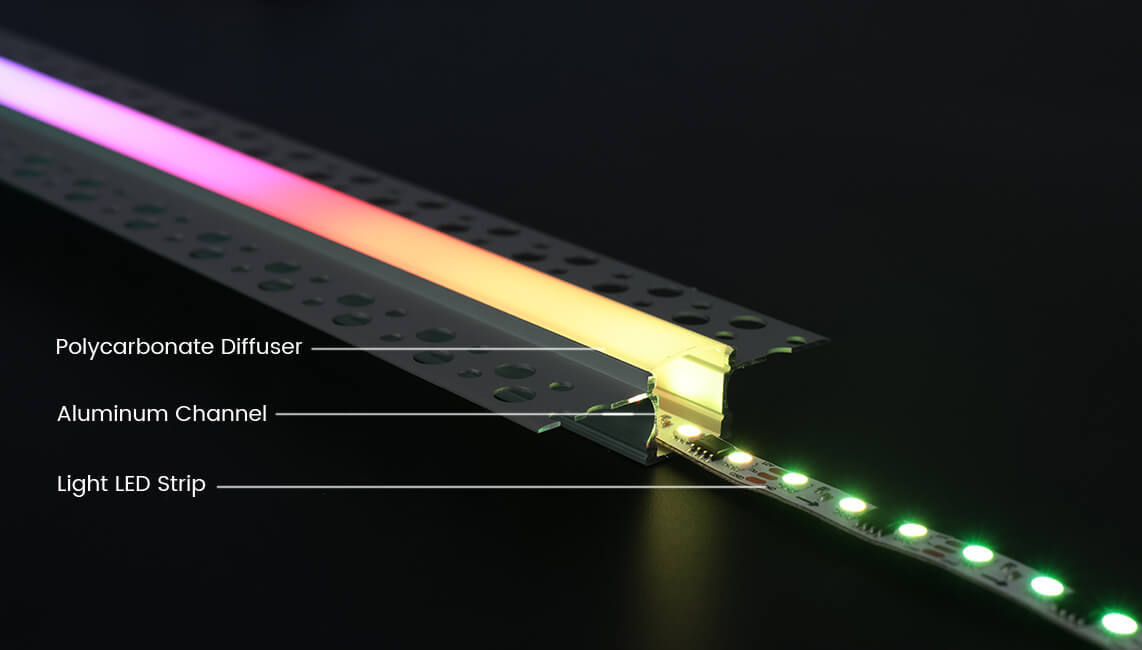LED Under Cabinet Lighting: Crafting A Custom Style for Your Kitchen
Are you seeking to illuminate your kitchen's undershelf area with energy-efficient, long-lasting LED under cabinet lighting but feeling overwhelmed by the options? This comprehensive guide will shed light and eliminate the guesswork involved with selecting, installing, and leveraging LEDs to spotlight meal prep areas, illuminate dishware displays, or set unique accent tones under your cabinets.

We'll provide data-backed advice so you can make an informed lighting decision tailored to the countertop materials, cabinets, typical tasks, and aesthetic of your specific kitchen configuration. Let's unlock the magic with LED under cabinet lighting customized to your cooking zone!
『Decoding Key Terminology and Specs』
Like any lighting category, LED lighting technical terms can generate more confusion than clarity. We'll decode the most critical metrics upfront so you can analyze options apples-to-apples:
★ Lumens indicate the total light output across the LED strip surface. Most kitchen undershelf task lighting requires 800-1500 lumens for adequate food prep area visibility, depending on counter depth. Commercial kitchens may need upwards of 2000+.
★ CRI (Color Rendering Index) quantifies an under cabinet LED lights’ ability to accurately reproduce colors on a 1-100 scale. The higher the CRI, the better tones render without unnatural tinting. High 90+ CRI LED strips render food, spices, and cookware colors true to life. 85+ works for generic ambient lighting.
★ CCT (Correlated Color Temperature) describes perceived light appearance from warmer 2700-3000K yellow tones to cooler 4000-6500K blueish hues. 3000-4000K CCT balances visibility and eye comfort best for LED under cabinet lighting.
★ Wattage shows power consumption in Watts. Lower-watt under cabinet LED lights maximize energy savings potential, cutting electric bills by ~85% over fluorescent.
Now that the terminology is clear, let's examine how to choose and install strips tailored to your under cabinet LED lights' unique needs...
『Choosing Strips to Match Your Kitchen's Functions』
First, consider application - 800+ lumen LED strips render prepping and cooking safely for task lighting over key work areas. For ambient lighting over dining nooks, 300-500 lumens works. Blend adjustable color temps to balance vibrance and comfort.
Seek out durable, UL-certified tape lights designed specifically for LED under cabinet lighting use with wide 120° beam angles to spread light evenly across counters without shadows or eye fatigue.
For built-in hardwired installation, allow an electrician to safely embed wires out of sight. For plug-in flexibility, ensure ample receptacle availability, spacing standard 5-meter strips ~3 feet apart.
Optional aluminum LED channels and extrusions with integrated diffusers enhance heat dissipation and diffuse light beautifully.

『Optimizing LED Placement for Seamless Illumination』
Properly positioning LED strips makes unveiling your kitchen’s full potential smooth and seamless. Let’s explore how to account for key factors:
- Distance strips 2-4 inches from the counter’s front edge so the 120° downward beam angle illuminates work zones without shadows or eye glaze. At 3 inches, light spreads evenly across an average of 25-inch deep countertops.
- Spot focus 800-1300 lumen LEDs over main cooking areas for food prep safety. Ambient 300-lumen strips suffice over dining nooks. Adjust color temperatures to balance vibrance and comfort.
- Map electrical outlets beforehand when planning built-in placement. Conceal wiring neatly inside channels or cabinet frames using track molding and clips.
Hardwired Installation & Plug-In LED Installation Guide 📖
Method |
Hardwired Method | Plug-In Method |
Pros |
Creates an integrated, seamless built-in look without any visible wires or outlets. This allows cabinets and lighting to flow as one unified fixture. |
Enables convenient DIY installation without a professional electrician. Modular LED power connector cords simply plug into nearby wall outlets. |
Cons |
Requires hiring a professional electrician which increases installation costs. | Visible dangling wires may disrupt aesthetics depending on implementation and outlet locations. |
Installation-Hardwired Method
✔ Map out the exact LED strip and power lead positioning based on the kitchen layout.
✔ Turn off relevant kitchen electrical circuit breakers for safety.
✔ Electrician routes low voltage wires behind drywall from LED driver locations to cabinets.
✔ Cut channels/gaps in drywall panels allowing flush wire embedding.
✔ Mount LED strips and wiring according to earlier mapped plans.
Installation-Plug-In Method
■ Examine kitchen layout to identify ideal LED strip sections based on outlet positioning every ~3 ft.
■ Select a suitable common household plug outlet to insert the connector cord based on available voltage/amps.
■ Keep connectors and drivers easily accessible for adjustments instead of fully embedded.
■ Run flat adhesive cable guides as needed to adhere connector wires against the mounting surface neatly.
■ Plug the assembled LED strip power cord into a chosen wall outlet to light up.
Unify styles with matching home fixtures with separate remote controls, allowing you to instantly change shades and brightness levels for any task or mood.
『conclusion』
This guide eliminates the guesswork in optimizing under cabinet LED lights for your unique kitchen. Focus time on planning wattage, placement, and lighting zones rather than solely upfront costs. Enjoy energy savings and brilliance for years to come!
Q&A
Q1: Do all LED strip lights provide equal brightness and durability?
A1: Unfortunately not. Significant variability exists across LED strips in terms of luminosity, lifespan, and overall quality. It depends on critical factors like the LED chip quality, PCB construction, and heat dissipation effectiveness. High-end LED strips incorporate premium components rated to last 50,000+ hours without luminance degradation. However, cheaper strips with fewer LEDs and poorer heat management can decay or burn out in under 10,000 hours.
Q2: How does LED beam angle affect LED Under Cabinet Lighting?
A2: The beam angle determines how widely light spreads across a surface. For smooth under cabinet LED lights without shadows or glare, strips with a wide 120-degree beam angle work best. This angled distribution helps the light reach all areas of your countertop evenly. Suited beam angles prevent light hotspots or dark spots.
Q3: Can LED strip lighting be dimmed for variable kitchen ambiance?
A3: Yes, provided you choose strips specifically rated as dimmable and pair them with compatible 0-10V or PWM dimmer switches. These technologies allow you to smoothly adjust your under cabinet LED lights brightness to create perfect mood lighting tones during meal times or occasions. Just ensure your dimmer switch and LED driver are cross-compatible before installing.
ABOUT THE AUTHOR




